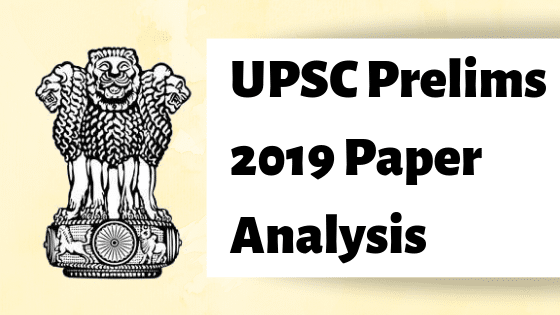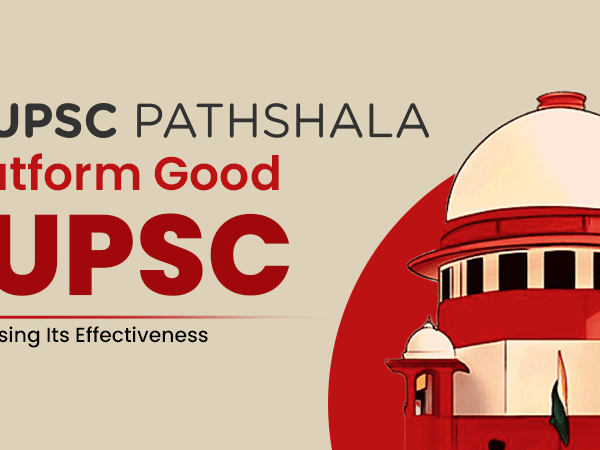The UPSC CSE Prelims 2019, conducted on 2nd June 2019 was a mixed bag of questions. Overall the paper ranged from moderate to difficult. But the difficulty level varied in the various subjects. Here is the analysis of the paper:
| UPSC PATHSHALA PRELIMS 2019 PAPER I ANALYSIS |
|||||
|---|---|---|---|---|---|
| Subject | Questions | Topics Covered |
|||
| Easy | Moderate | Difficult | Total | ||
| History | 0 | 6 | 2 | 8 | |
| Ancient | 0 | 0 | 0 | 0 | |
| Medieval | 0 | 3 | 1 | 4 | Land rights, Delhi Sultanate, Mughal Culture |
| Modern | 0 | 3 | 1 | 4 | Swadeshi Movement, Social associations, Nationalist struggle |
| Art and culture | 0 | 1 | 5 | 6 | Harappan civilisation, Buddhism, Temple Architecture, Mughal Art |
| Geography | 0 | 3 | 5 | 8 | Map based questions, climatology, physiology of the earth |
| Environment and ecology | 0 | 8 | 10 | 18 | Government environmental provisions, Biodiversity, Biosphere reserves, International conventions |
| Polity | 1 | 10 | 8 | 19 | Historical Evolution of the constitution, Government Bills, Office of Governor, Judiciary, Government regulatory bodies, constitutional values, Fundamental Rights, State Governments |
| Science and Technology | 1 | 3 | 9 | 13 | Technological development: communication, electronics, wearable technology, biotechnology, Recent findings in healthcare and diseases |
| Economics | 1 | 12 | 10 | 23 | Banking and financial institutions, Energy and infrastructure, Indexes, Agriculture, Five Year Plans, Rupee convertibility, Land reforms, Poverty, PPP, Public debt |
| Government Schemes | 0 | 2 | 0 | 2 | |
| International Relations | 0 | 1 | 2 | 3 | |
| Total | 3 | 46 | 51 | 100 | |
| Current Affairs | 6 | 20 | 19 | 35 | Various schemes, new technological developments, economic concepts |
Subjectwise Analysis
Lets us begin to analyse the questions subject wise.
- The trend changed drastically in history. Compared to last year, this year only 8 questions were asked from history and those too were from the Medieval and Modern History. Last year 19 questions were asked in history from ancient and medieval history. Also, the topics covered in the questions were typical this year from Mughal Sultanate to Nationalist struggle of India. For Art and Culture as well, the weightage has reduced greatly. Except for the question on Buddhism, the rest of the questions were facts which were difficult to recollect.
- In geography the trend continues with majority of questions being map based questions. However, even application based questions were asked like dewdrops not forming on a cloudy night and movement of sun wrt earth. In environment and ecology the questions were purely factual, reinforcing the stress on reading and revising the concepts again and again. The sheer increase in the number of questions from environment again brings back the importance of this section. This proves that we simply cannot ignore this section ever.
- With nineteen questions, polity has maintained its importance year after year. Even though the questions were difficult, they could be solved by focusing on topics covered in current affairs like office of profit, governor, judiciary etc.
- Science and technology questions highlight the fact that there is no need to cover the basic sciences like physics, chemistry and biology. The focus should be on the day to day happenings of S&T. Topics like technological development: communication, electronics, wearable technology, biotechnology, recent findings in healthcare and diseases need to be focused on which appear everyday in the papers.
- This year maximum questions were from economics covering both static and dynamic concepts. In static concepts, economics is shifting from application based ( how does repo, reverse repo works) to factual based (question on bank boards). Also, the trend has shifted from questions on RBI to Banking and financial institutions which was majorly in news.
- In current affairs 35 questions were asked while rest were static questions. Just keeping one updated with the understanding and analysis of news would have made scoring these 35 questions easy. Always remember, Current Affairs is the low hanging fruit, if you are simply understanding the analysis of news regularly.
Key Strategy Points for Prelims 2020
Keeping in line with the trends this year we can make certain changes in our preparation strategy for prelims 2020:
- Major focus topics: Geography & History which can have the majority of the questions.
- Do not ignore the environment and ecology. In this section, the focus should be on new flora and fauna found, new national parks etc. Since the Paris agreement is due to be signed in the near future, the focus should also be on climate change.
- In Economics and polity, make a list of the topics that are regularly in the news and cover the topics extensively.
- Make a list of all the draft government bills and new government schemes for the coming years. Surely 5-6 questions would be asked from this section.
- In Geography, do as many map-based questions as possible. Any serious aspirant can no longer ignore studying maps thoroughly along with static data in Geography.
The general trend of the paper shows that UPSC keeps changing sections and focus of the paper based on the current happenings and what has not been asked in previous 2-3 years. Analysing these two aspects can help a candidate cover the syllabus in an optimum manner.
Key Strategy Points for Mains 2019
- Awareness of economic current affairs: It is expected to grab a lion’s share in the Mains 2019. Wait for the new Economic Survey to come and cover it properly.
- Environment: Understand everything related to this topic. Old classic treaties to the latest action plans, everything is important.
- Polity: Latest bills, static information based on current affairs, disputes will be asked to be explained in detail.
Show Comments





